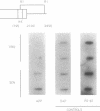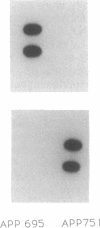Abstract
The pathological hallmark of Alzheimer disease is the accumulation of neurofibrillary tangles and neuritic plaques in the brains of patients. Plaque cores contain a 4- to 5-kDa amyloid beta-protein fragment which is also found in the cerebral blood vessels of affected individuals. Since amyloid deposition in the brain increases with age even in normal people, we sought to establish whether the disease state bears a direct relationship with normal aging processes. As a model for biological aging, the process of cellular senescence in vitro was used. mRNA levels of beta-amyloid precursor protein associated with Alzheimer disease were compared in human fibroblasts in culture at early passage and when the same fibroblasts were grown to senescence after more than 52 population doublings. A dramatic increase in mRNA was observed in senescent IMR-90 fibroblasts compared with early-passage cells. Hybridization of mRNA from senescent and early proliferating fibroblasts with oligonucleotide probes specific for the three alternatively spliced transcripts of the gene gave similar results, indicating an increase during senescence of all three forms. A similar, though more modest, increase in message levels was also observed in early-passage fibroblasts made quiescent by serum deprivation; with repletion of serum, however, the expression returned to previous low levels. ELISAs were performed on cell extracts from senescent, early proliferating, and quiescent fibroblasts, and quiescent fibroblasts repleted with serum for over 48 hr, using polyclonal antibodies to a synthetic peptide of the beta-amyloid precursor. The results confirmed that the differences in mRNA expression were partially reflected at the protein level. Regulated expression of beta-amyloid precursor protein may be an important determinant of growth and metabolic responses to serum and growth factors under physiological as well as pathological conditions.
Full text
PDF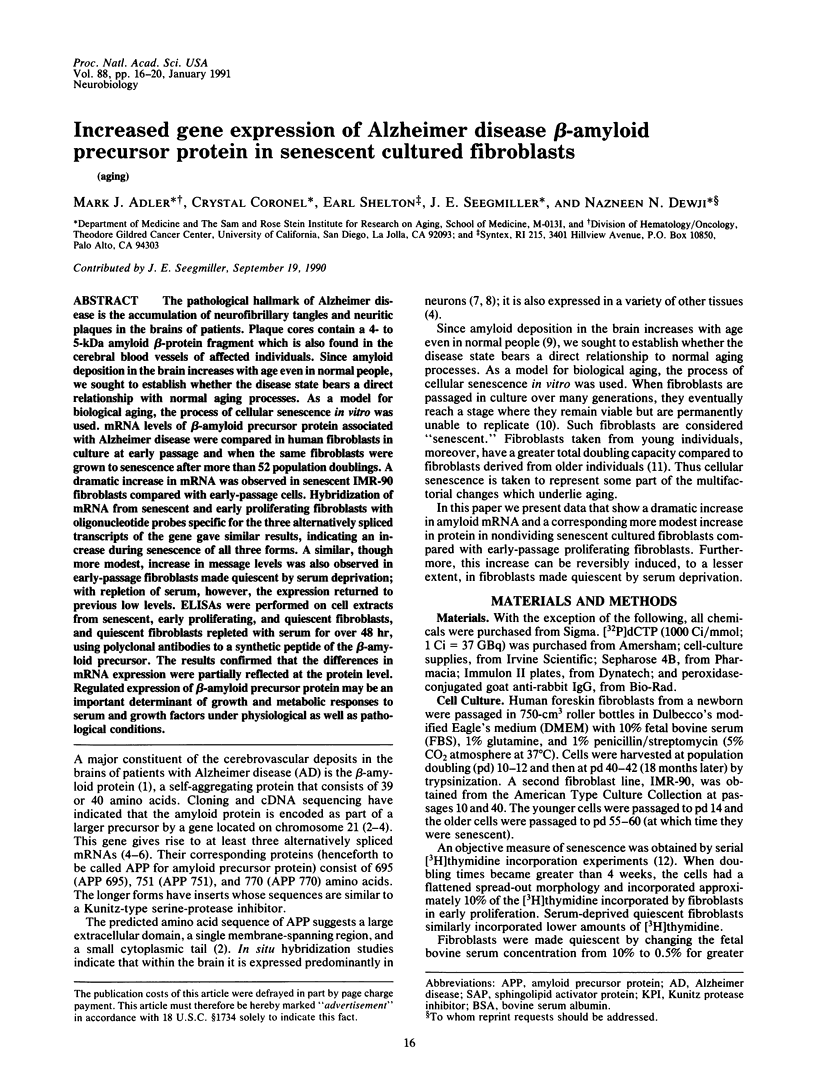
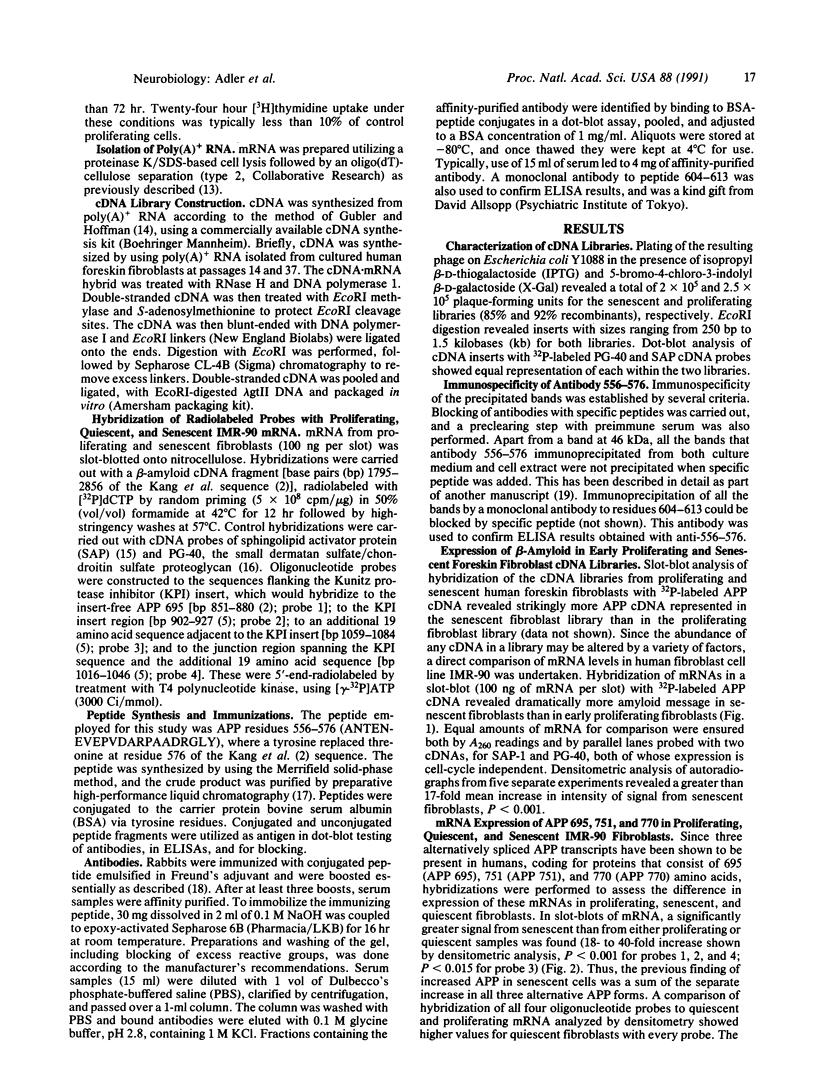
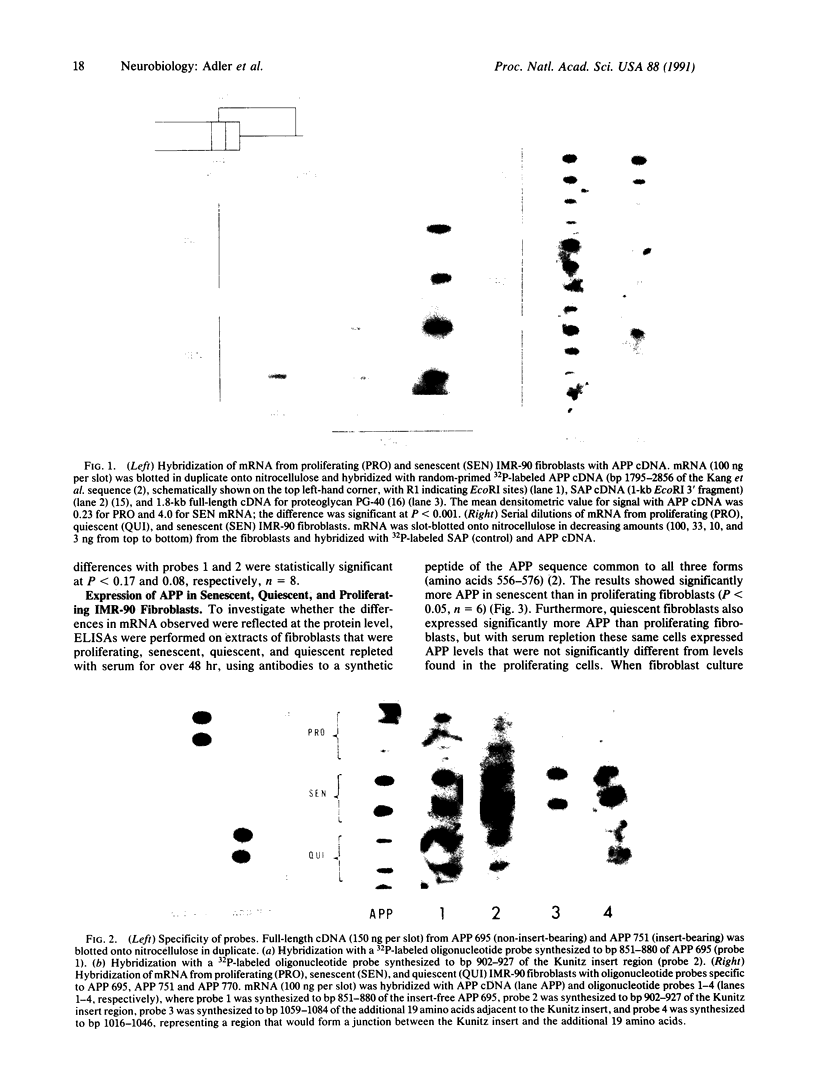
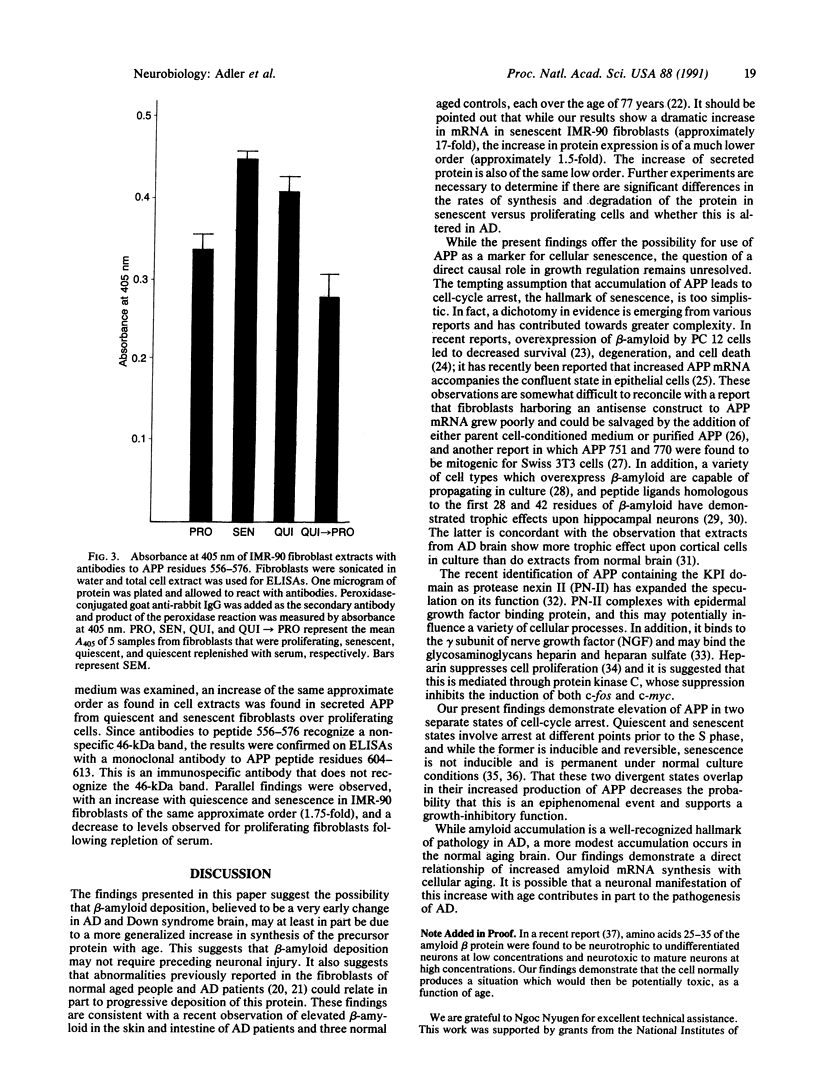
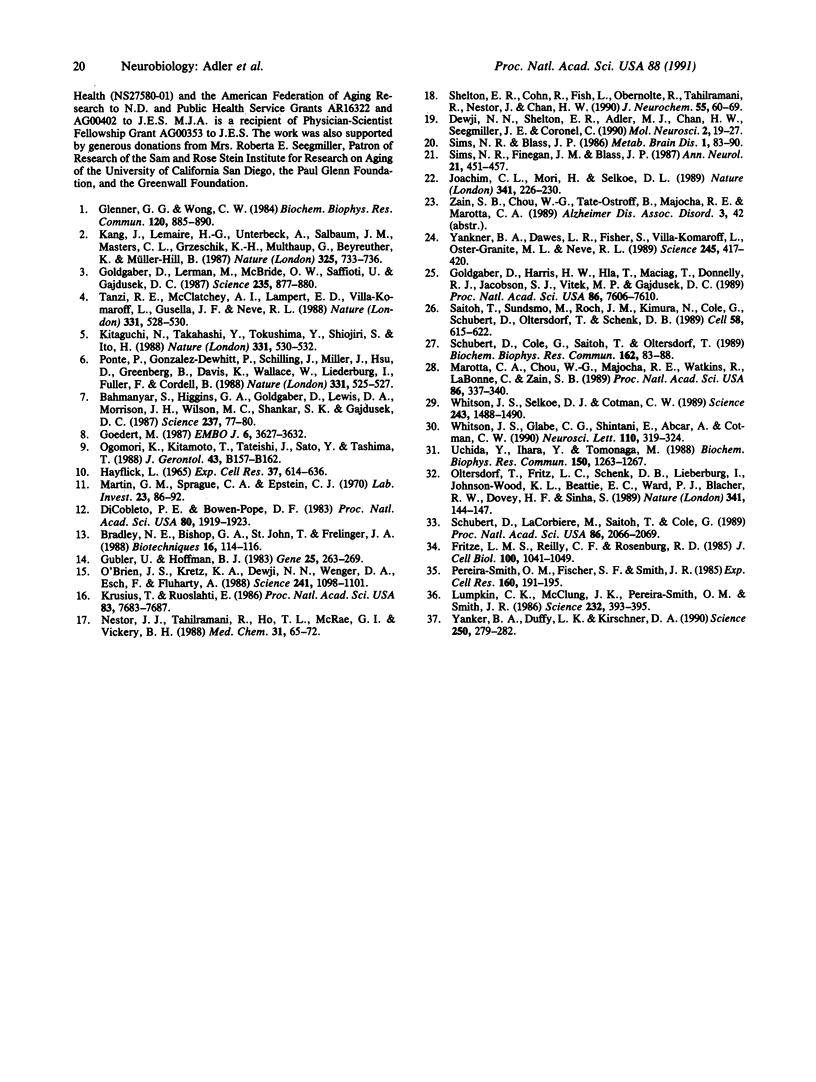
Images in this article
Selected References
These references are in PubMed. This may not be the complete list of references from this article.
- Badley J. E., Bishop G. A., St John T., Frelinger J. A. A simple, rapid method for the purification of poly A+ RNA. Biotechniques. 1988 Feb;6(2):114–116. [PubMed] [Google Scholar]
- Bahmanyar S., Higgins G. A., Goldgaber D., Lewis D. A., Morrison J. H., Wilson M. C., Shankar S. K., Gajdusek D. C. Localization of amyloid beta protein messenger RNA in brains from patients with Alzheimer's disease. Science. 1987 Jul 3;237(4810):77–80. doi: 10.1126/science.3299701. [DOI] [PubMed] [Google Scholar]
- Dewji N. N., Shelton E. R., Adler M. J., Chan H. W., Seegmiller J. E., Coronel C. Processing of Alzheimer's disease-associated beta-amyloid precursor protein. J Mol Neurosci. 1990;2(1):19–27. doi: 10.1007/BF02896922. [DOI] [PubMed] [Google Scholar]
- DiCorleto P. E., Bowen-Pope D. F. Cultured endothelial cells produce a platelet-derived growth factor-like protein. Proc Natl Acad Sci U S A. 1983 Apr;80(7):1919–1923. doi: 10.1073/pnas.80.7.1919. [DOI] [PMC free article] [PubMed] [Google Scholar]
- Fritze L. M., Reilly C. F., Rosenberg R. D. An antiproliferative heparan sulfate species produced by postconfluent smooth muscle cells. J Cell Biol. 1985 Apr;100(4):1041–1049. doi: 10.1083/jcb.100.4.1041. [DOI] [PMC free article] [PubMed] [Google Scholar]
- Glenner G. G., Wong C. W. Alzheimer's disease: initial report of the purification and characterization of a novel cerebrovascular amyloid protein. Biochem Biophys Res Commun. 1984 May 16;120(3):885–890. doi: 10.1016/s0006-291x(84)80190-4. [DOI] [PubMed] [Google Scholar]
- Goedert M. Neuronal localization of amyloid beta protein precursor mRNA in normal human brain and in Alzheimer's disease. EMBO J. 1987 Dec 1;6(12):3627–3632. doi: 10.1002/j.1460-2075.1987.tb02694.x. [DOI] [PMC free article] [PubMed] [Google Scholar]
- Goldgaber D., Harris H. W., Hla T., Maciag T., Donnelly R. J., Jacobsen J. S., Vitek M. P., Gajdusek D. C. Interleukin 1 regulates synthesis of amyloid beta-protein precursor mRNA in human endothelial cells. Proc Natl Acad Sci U S A. 1989 Oct;86(19):7606–7610. doi: 10.1073/pnas.86.19.7606. [DOI] [PMC free article] [PubMed] [Google Scholar]
- Goldgaber D., Lerman M. I., McBride O. W., Saffiotti U., Gajdusek D. C. Characterization and chromosomal localization of a cDNA encoding brain amyloid of Alzheimer's disease. Science. 1987 Feb 20;235(4791):877–880. doi: 10.1126/science.3810169. [DOI] [PubMed] [Google Scholar]
- Gubler U., Hoffman B. J. A simple and very efficient method for generating cDNA libraries. Gene. 1983 Nov;25(2-3):263–269. doi: 10.1016/0378-1119(83)90230-5. [DOI] [PubMed] [Google Scholar]
- HAYFLICK L. THE LIMITED IN VITRO LIFETIME OF HUMAN DIPLOID CELL STRAINS. Exp Cell Res. 1965 Mar;37:614–636. doi: 10.1016/0014-4827(65)90211-9. [DOI] [PubMed] [Google Scholar]
- Joachim C. L., Mori H., Selkoe D. J. Amyloid beta-protein deposition in tissues other than brain in Alzheimer's disease. Nature. 1989 Sep 21;341(6239):226–230. doi: 10.1038/341226a0. [DOI] [PubMed] [Google Scholar]
- Kang J., Lemaire H. G., Unterbeck A., Salbaum J. M., Masters C. L., Grzeschik K. H., Multhaup G., Beyreuther K., Müller-Hill B. The precursor of Alzheimer's disease amyloid A4 protein resembles a cell-surface receptor. Nature. 1987 Feb 19;325(6106):733–736. doi: 10.1038/325733a0. [DOI] [PubMed] [Google Scholar]
- Kitaguchi N., Takahashi Y., Tokushima Y., Shiojiri S., Ito H. Novel precursor of Alzheimer's disease amyloid protein shows protease inhibitory activity. Nature. 1988 Feb 11;331(6156):530–532. doi: 10.1038/331530a0. [DOI] [PubMed] [Google Scholar]
- Krusius T., Ruoslahti E. Primary structure of an extracellular matrix proteoglycan core protein deduced from cloned cDNA. Proc Natl Acad Sci U S A. 1986 Oct;83(20):7683–7687. doi: 10.1073/pnas.83.20.7683. [DOI] [PMC free article] [PubMed] [Google Scholar]
- Lumpkin C. K., Jr, McClung J. K., Pereira-Smith O. M., Smith J. R. Existence of high abundance antiproliferative mRNA's in senescent human diploid fibroblasts. Science. 1986 Apr 18;232(4748):393–395. doi: 10.1126/science.2421407. [DOI] [PubMed] [Google Scholar]
- Marotta C. A., Chou W. G., Majocha R. E., Watkins R., LaBonne C., Zain S. B. Overexpression of amyloid precursor protein A4 (beta-amyloid) immunoreactivity in genetically transformed cells: implications for a cellular model of Alzheimer amyloidosis. Proc Natl Acad Sci U S A. 1989 Jan;86(1):337–341. doi: 10.1073/pnas.86.1.337. [DOI] [PMC free article] [PubMed] [Google Scholar]
- Martin G. M., Sprague C. A., Epstein C. J. Replicative life-span of cultivated human cells. Effects of donor's age, tissue, and genotype. Lab Invest. 1970 Jul;23(1):86–92. [PubMed] [Google Scholar]
- Nestor J. J., Jr, Tahilramani R., Ho T. L., McRae G. I., Vickery B. H. Potent, long-acting luteinizing hormone-releasing hormone antagonists containing new synthetic amino acids: N,N'-dialkyl-D-homoarginines. J Med Chem. 1988 Jan;31(1):65–72. doi: 10.1021/jm00396a011. [DOI] [PubMed] [Google Scholar]
- O'Brien J. S., Kretz K. A., Dewji N., Wenger D. A., Esch F., Fluharty A. L. Coding of two sphingolipid activator proteins (SAP-1 and SAP-2) by same genetic locus. Science. 1988 Aug 26;241(4869):1098–1101. doi: 10.1126/science.2842863. [DOI] [PubMed] [Google Scholar]
- Ogomori K., Kitamoto T., Tateishi J., Sato Y., Tashima T. Aging and cerebral amyloid: early detection of amyloid in the human brain using biochemical extraction and immunostain. J Gerontol. 1988 Nov;43(6):B157–B162. doi: 10.1093/geronj/43.6.b157. [DOI] [PubMed] [Google Scholar]
- Oltersdorf T., Fritz L. C., Schenk D. B., Lieberburg I., Johnson-Wood K. L., Beattie E. C., Ward P. J., Blacher R. W., Dovey H. F., Sinha S. The secreted form of the Alzheimer's amyloid precursor protein with the Kunitz domain is protease nexin-II. Nature. 1989 Sep 14;341(6238):144–147. doi: 10.1038/341144a0. [DOI] [PubMed] [Google Scholar]
- Ponte P., Gonzalez-DeWhitt P., Schilling J., Miller J., Hsu D., Greenberg B., Davis K., Wallace W., Lieberburg I., Fuller F. A new A4 amyloid mRNA contains a domain homologous to serine proteinase inhibitors. Nature. 1988 Feb 11;331(6156):525–527. doi: 10.1038/331525a0. [DOI] [PubMed] [Google Scholar]
- Saitoh T., Sundsmo M., Roch J. M., Kimura N., Cole G., Schubert D., Oltersdorf T., Schenk D. B. Secreted form of amyloid beta protein precursor is involved in the growth regulation of fibroblasts. Cell. 1989 Aug 25;58(4):615–622. doi: 10.1016/0092-8674(89)90096-2. [DOI] [PubMed] [Google Scholar]
- Schubert D., Cole G., Saitoh T., Oltersdorf T. Amyloid beta protein precursor is a mitogen. Biochem Biophys Res Commun. 1989 Jul 14;162(1):83–88. doi: 10.1016/0006-291x(89)91965-7. [DOI] [PubMed] [Google Scholar]
- Schubert D., LaCorbiere M., Saitoh T., Cole G. Characterization of an amyloid beta precursor protein that binds heparin and contains tyrosine sulfate. Proc Natl Acad Sci U S A. 1989 Mar;86(6):2066–2069. doi: 10.1073/pnas.86.6.2066. [DOI] [PMC free article] [PubMed] [Google Scholar]
- Shelton E. R., Cohn R., Fish L., Obernolte R., Tahilramani R., Nestor J. J., Chan H. W. Characterization of beta-amyloid precursor proteins with or without the protease-inhibitor domain using anti-peptide antibodies. J Neurochem. 1990 Jul;55(1):60–69. doi: 10.1111/j.1471-4159.1990.tb08821.x. [DOI] [PubMed] [Google Scholar]
- Sims N. R., Blass J. P. Phosphofructokinase activity in fibroblasts from patients with Alzheimer's disease and age- and sex-matched controls. Metab Brain Dis. 1986 Mar;1(1):83–90. doi: 10.1007/BF00998479. [DOI] [PubMed] [Google Scholar]
- Sims N. R., Finegan J. M., Blass J. P. Altered metabolic properties of cultured skin fibroblasts in Alzheimer's disease. Ann Neurol. 1987 May;21(5):451–457. doi: 10.1002/ana.410210507. [DOI] [PubMed] [Google Scholar]
- Tanzi R. E., McClatchey A. I., Lamperti E. D., Villa-Komaroff L., Gusella J. F., Neve R. L. Protease inhibitor domain encoded by an amyloid protein precursor mRNA associated with Alzheimer's disease. Nature. 1988 Feb 11;331(6156):528–530. doi: 10.1038/331528a0. [DOI] [PubMed] [Google Scholar]
- Uchida Y., Ihara Y., Tomonaga M. Alzheimer's disease brain extract stimulates the survival of cerebral cortical neurons from neonatal rats. Biochem Biophys Res Commun. 1988 Feb 15;150(3):1263–1267. doi: 10.1016/0006-291x(88)90765-6. [DOI] [PubMed] [Google Scholar]
- Whitson J. S., Glabe C. G., Shintani E., Abcar A., Cotman C. W. Beta-amyloid protein promotes neuritic branching in hippocampal cultures. Neurosci Lett. 1990 Mar 14;110(3):319–324. doi: 10.1016/0304-3940(90)90867-9. [DOI] [PubMed] [Google Scholar]
- Whitson J. S., Selkoe D. J., Cotman C. W. Amyloid beta protein enhances the survival of hippocampal neurons in vitro. Science. 1989 Mar 17;243(4897):1488–1490. doi: 10.1126/science.2928783. [DOI] [PubMed] [Google Scholar]
- Yankner B. A., Dawes L. R., Fisher S., Villa-Komaroff L., Oster-Granite M. L., Neve R. L. Neurotoxicity of a fragment of the amyloid precursor associated with Alzheimer's disease. Science. 1989 Jul 28;245(4916):417–420. doi: 10.1126/science.2474201. [DOI] [PubMed] [Google Scholar]
- Yankner B. A., Duffy L. K., Kirschner D. A. Neurotrophic and neurotoxic effects of amyloid beta protein: reversal by tachykinin neuropeptides. Science. 1990 Oct 12;250(4978):279–282. doi: 10.1126/science.2218531. [DOI] [PubMed] [Google Scholar]



